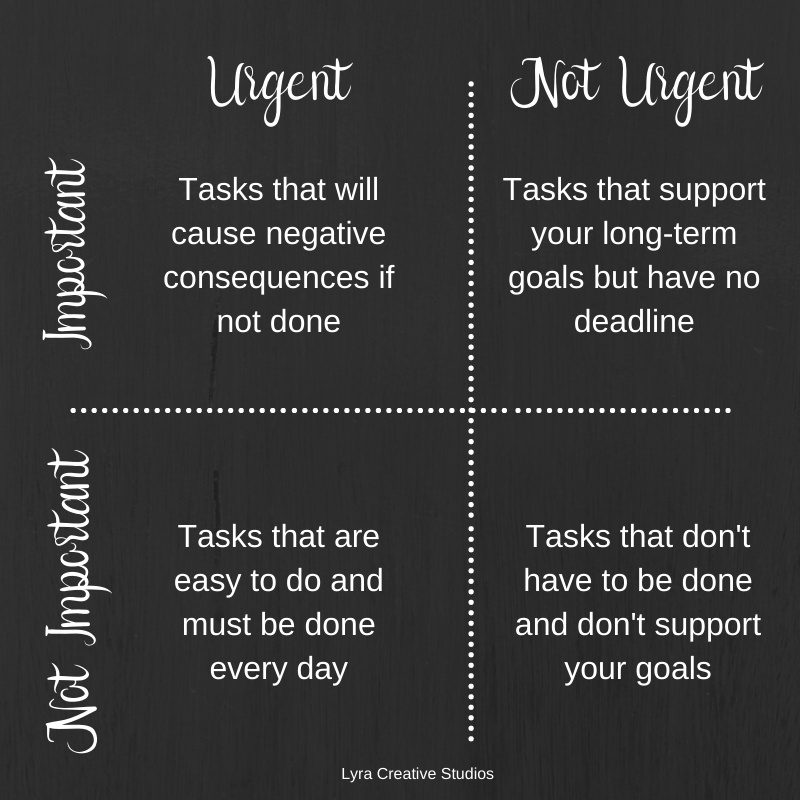How to Stop Procrastinating with the Eisenhower Matrix
In the modern workplace, productivity is prioritized, which means that procrastination is the bane of our existence. Even highly skilled people may find themselves putting off important tasks. Why? Fear of failure. Lack of energy. But usually, one very simple reason:
An inability to prioritize.
Prioritizing is more than simply picking the “most important task.” There’s another factor at play: urgency. We humans are wired to respond to danger. In the workplace, that means we often feel compelled to tackle tasks that we associate with some sort of threat. Give a deadline to something, and we panic under action. That’s the reason that many of us “work well under pressure.”
Here’s the kicker: That’s not working well.
Urgent vs. Important
In 1961, President Dwight D. Eisenhower gave a speech in which he drew a line between the “urgent present” and the “important future.” It wasn’t the first time he’d explored this theme of urgent vs. important. Quoting someone whose name is lost to history, Eisenhower said, “I have two kinds of problems, the urgent and the important. The urgent are not important, and the important are never urgent.”
To Eisenhower, importance had to do with long-term goals and success, while urgent stuff was simply the day-to-day stuff that we tend to focus on. Think about that: How many of your daily tasks relate to the future you envision? Are you making time every day to work toward those long-term goals, or are you putting it off because you need to focus on the right now?
There’s nothing wrong with living for the present. But if you are trying to build something, procrastination is much more likely to affect your important tasks than your urgent ones. That’s because people are highly susceptible to the “Urgency Effect”: We want that feeling of satisfaction that comes from checking off a task with a deadline, and we dread what will happen if we don’t do that task.
Meanwhile, the important tasks that don’t have a deadline fall by the wayside. This includes writing our business plan, writing the next chapter of our book, taking the time to lay out our ideas. No deadline? No interest, say our brains.
How can we rewire our brains to overcome this? How can we stop procrastinating and start getting our important tasks done?
The Eisenhower Matrix
Productivity guru Stephen Covey translated Eisenhower’s ideas into a workable tool: the Eisenhower Matrix. It allows you to map which tasks are important, which are important, and which are neither.

In the upper left, we have our urgent tasks that are also important. These are typically the tasks we must do for our jobs. We tended to be motivated by the sense of urgency that comes from deadlines or the repercussions of not doing these tasks. However, staying in this quadrant can be addictive as we enjoy the endorphin boost from checking off those urgent tasks.
Similarly, we tend to feel “productive” when we’re knocking out the tasks that don’t really have to be done but tend to have a time-linked component. For example, it’s easy to spend a whole morning answering emails because they’re “urgent.” That may be so, but they’re not important.
Then of course, we tend to procrastinate by engaging in tasks that are neither urgent nor important, such as organizing files, checking social media, or reading magazines.
Many of us neglect the upper right quadrant of the matrix. It’s too easy to let these tasks slide. After all, we’re tired after doing our work (Urgent – Important) and our chores (Urgent – Not Important), and then we end up vegging (Not Urgent – Not Important). Now, downtime is important, but it should be balanced with the other quadrants.
Pairing the Eisenhower Matrix with Block Scheduling
There are four quadrants in the matrix: What if your day could be divided into four chunks to tackle it all? That’s the concept of block scheduling, in which you assign yourself “blocks” in which to group your tasks. The themes are:
Focus: When you do your intensive work, such as writing, planning, design, and other high-energy tasks
Admin: When you do the little things that don’t require a lot of mental or other energy but that need to be done
Recovery: When you relax and don’t do anything of substance
Social: When you spend time with loved ones and/or expand your hobbies or personal skills
The tasks at the bottom of the Eisenhower Matrix would fall into the Admin and Social blocks. Striking a balance among these tasks is crucial to true productivity. The block scheduling method advises people to schedule their blocks so that they can limit the time they spend on non-important, non-urgent tasks, yet still ward off burnout. The problem is that the Focus blocks tend to be consumed by Urgent tasks rather than Important ones.
By mapping your daily tasks into the matrix, you can see which tasks you might need to let fall off your list — and which you need to devote time to tackle.
What Goes in Which Quadrant
We’ve pretty well covered the Urgent – Important tasks. Where it gets complicated is the work stuff that isn’t important. Keep in mind, we’re not saying your work is unimportant, but rather that many of your daily tasks have short-term effects. The world won’t end if you don’t check your email one day, yet many of us cling to email as an excuse for not getting other work done. Remember, we’re talking about how to avoid procrastinating.
One of the most underrated means of boosting productivity and stopping procrastination is to build habits. These tasks, like your long-term strategy sessions or big projects with no deadlines, are important but not urgent. Devoting time to your habits can help bring order to the chaos and make you feel more in control. This in turn wards off procrastination.
Finally, your TV-watching time, reading time, and all those relaxing activities fall into the bottom right quadrant. Those are fine to keep in your Recovery blocks. What you really need to remove from your task list, however, are the junk tasks that do nothing for either your short-term needs or your long-term goals. We tend to fill up our lists with such tasks, if only to feel busy and productive. Avoid the temptation to color-code your notes from last year: Kick yourself into gear and tackle those Important – Not Urgent tasks!
Wrapping Up
Whatever your productivity system is, try doing a daily task dump into the Eisenhower Matrix. Seeing it laid out visually can help you see where your daily tasks have been falling. Is one quadrant fuller than the others? Aim to bring balance to all four quadrants, then assign them to the appropriate blocks.
Once you feel a bit more control over your task list, you’ll be less likely to overcompensate for your anxiety by hyper-focusing on Urgent – Important or Urgent – Not Important tasks — or retreating to your couch for some quality Not Urgent – Not Important stuff.
Need to get some stuff off your plate? Lyra Creative Studios offers a range of creative services to help you get stuff done.
Want more great content? Check out our Medium publication, Big Top Business.

